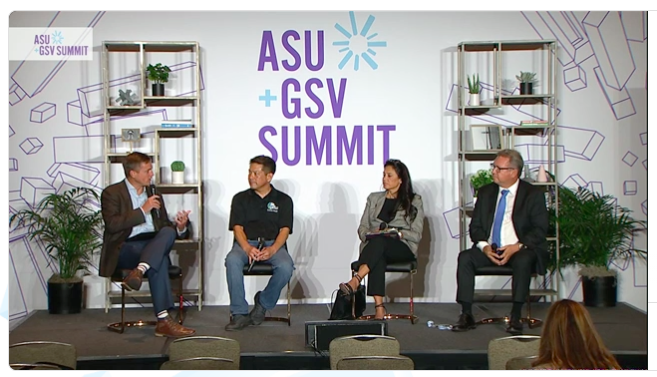
The ASU+GSV Summit is a collaboration between Arizona State University (ASU) and Global Silicon Valley (GSV) to connect leading minds focused on transforming society and business around learning and work. The event was held August 9-11 both virtually and live in San Diego.
Much of this year’s conversation was based on the changes brought on by the COVID-19 pandemic and how we can recover equitably. Here are a few ideas we came away with.
1. Upskilling continues to be a critical workforce solution
The World Economic Forum estimates 50% of the workforce will need to be re-skilled or upskilled just to keep pace with technological advances. Susan Cates, the managing partner with Leeds Equity spoke on how this upskilling can be achieved.
“Companies have the most skin in the game, they have the most immediate pain points around supporting their employees in developing the skills they need for the company to be successful, so I expect them to continue to be in the driver’s seat in terms of ownership around upskilling. But they can’t do it themselves, and they shouldn’t do it by themselves. There is a need for our traditional education institutions to ensure they are working with companies to support the development of skills of the feature. And the need that the government has to support that.”
2. New learning models are opportunities to increase access
While the COVID-19 pandemic disrupted the traditional model of learning, it has forced new models to emerge that create great opportunities to remove barriers to access for rural and underserved students to participate in internships, apprenticeships and other career focused learning.
“We were really able to pivot and provide a lot of virtual interactions for students which really allowed us to increase access. With half a million students, no matter what we do in person, we are never going to hit the number of students we really want to have these experiences,” says Jewyl Alderson Clarke, the integrated curriculum coordinator for San Diego County Office of Education.
3. Some pandemic related changes are here to stay
Sarah Burns, Workforce Partnership director of learning, shared her experience with new virtual conference software that allowed for more intentional networking, particularly for those who have never made professional connections before.
“The conference software has been successful in starting to get our program participants into that space of talking to someone new, of connecting, even if it’s not always as natural per say as being in a room. But we’ve also found it’s even more effective for some than being in the room. There is a different kind of comfort that you have with clicking on a virtual table with other participants instead of walking around a bunch of tables and trying to sidle up to someone and start a conversation.”
4. We must advance access, equity and opportunity to elevate workers
A key component in achieving equity and opportunity lies in expanding access to quality higher education.
“We need access to education, we need cost efficient education, but then when we get there, we need facility and staff and the village that believes in students, that believes that they can achieve, that’s going to give them a high-quality education, and that’s going to create these transformational learning experiences,” says Lynn Wooten, president of Simmons University.
Additionally, Workforce Partnership CEO Peter Callstrom spoke with Working Nation during the summit about our Income Share Agreements and how they can provide affordable access to learning. “Income share agreements are helping to close this opportunity gap.” Watch the full video here.
5. Increasing skill-based learning and hiring will result in equitable outcomes
The paradigm shift to skill-based hiring is changing the landscape for students, school districts and employers. Policymakers, business leaders and education leaders have the opportunity to leverage technology to foster skill development and ensure equal opportunity for all.
“We’ve progressed from a skills gap conversation to a communication of skills gap conversation, to a skill-based hiring conversation,” says Jake Hirsch-Allen, North America workforce development and higher ed system lead for LinkedIn Learning.
Make sure to check out other sessions with our staff and board members:
- Our CEO also spoke on a panel with Workforce Development Board chair, Sammy Totah, on The Grand Challenge of Reskilling America.
- Board member Ed Hidalgo had two sessions: How Workforce Development is Empowering Possibilities panel and The Purpose of K-12: Instilling Hope.
- Our chief impact officer, Andy Hall moderated Partners or Silos? Reimagining Education & Workforce Development.
- Board member Mimi Rosado spoke on the Individualized Pathways for a New Era of Learning panel.
